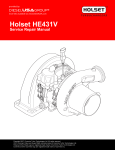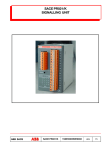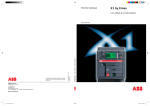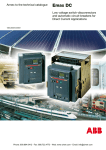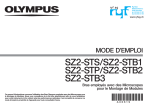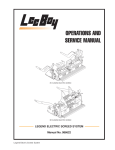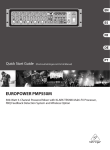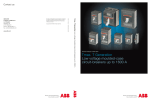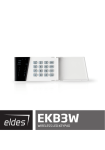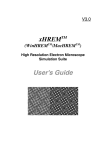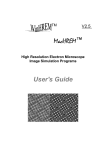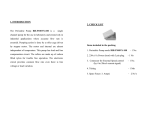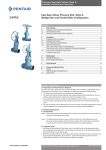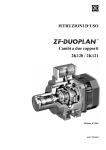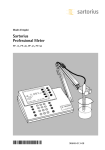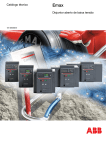Download T8-User-Manual - Switchgear and Switchboard Portal
Transcript
IInstallation and service instructions Installation, service and maintenance instructions for low voltage moulded case circuit-breakers 1SDH000682R0002 Tmax T8 L3692 Dwg. Resp. Off. LB-DTAT Take over Off. App. Model L3692 Title Installation, service and maintenance instructions for low voltage moulded case circuit-breakers Apparatus ABB SACE Division Doc.No. Tmax T8 1SDH000682R0002 Language en Scale Index 1. Description ................................................................ pag. 3 1.1 General characteristics................................................... « 3 1.2 1.3.1 External front view of the circuit-breaker ....................... « IEC Circuit-breaker rating plate data ............................ « 3 3 1.3.2 UL Circuit-breaker rating plate data ............................. « 3 2. Checking on receipt ....................................................... « 3 3. Storage, lifting and weights ........................................... « 3 4. Installation ....................................................................... « 4 4.1 4.2 Installation room .............................................................. « Installation of the flange on the compartment door ....... « 4 4 5. Electrical connections ..................................................... « 5 5.1 Connections to the power circuit ................................... « 5 5.1.1 Shapes of the terminals .................................................. « 5 5.1.2 5.1.3 Examples of positioning the connection busbars according to the types of terminals ............................. « Assembly procedure for the connection busbars ........ « 5 6 5.2 Wiring the circuit-breaker auxiliary circuits .................... « 6 6. Putting into service ......................................................... « 7 6.1 General procedures ....................................................... « 7 7. Instructions for use ......................................................... « 8 7.1 Operating and signalling parts ...................................... « 8 7.2 Circuit-breaker closing and opening procedures ........ « 8 8. Maintenance ................................................................... « 10 8.1 Warning .......................................................................... « 10 8.2 Maintenance program .................................................... « 10 8.3 Maintenance operations ................................................. « 11 8.3.1 Preliminary operations .................................................... « 11 8.3.2 8.3.3 General inspection of the circuit-breaker ...................... « 11 Operating mechanism maintenance ............................. « 11 9. Measures to be taken for any operating anomalies ...................................................................... « 12 10. Accessories ..................................................................... « 13 10.1 10.2 10.3 Electrical accessories .................................................... « 13 Mechanical locks ........................................................... « 15 Spare parts .................................................................... « 15 11. Protection releases - References ................................... « 16 11.1 Safety notes .................................................................... « 16 11.1.1 Notes for dielectric stiffness tests ................................... « 16 11.2 General notes.................................................................. « 16 12. Overall dimensions ......................................................... « 17 13. Circuit diagrams ............................................................. « 23 Model L3692 Apparatus Doc. No. Tmax T8 1SDH000682R0002 Scale Page No. 1/29 Model L3692 Apparatus Doc.No. Tmax T8 1SDH000682R0002 Scale Page No. 2/29 1. Description 1.1 General characteristics Tmax T8 serie of circuit-breakers and disconnectors consist of a plastic structure which houses the operating mechanism, the poles and the auxiliary parts. Each pole, insulated from the others, contains the circuit-breaking parts and the current sensor of the corresponding phase. The fixed version circuit-breaker has its own terminals for connection to the power circuit. 1.2 External front view of the circuit-breaker 1 PR232/P-T8, PR331 o PR332 electronic microprocessor-based release 2 Operating and control parts of the operating mechanism and release tripped signals 3 Rating plate 1 3 2 Fixed circuit-breaker Fig. 1 1.3.1 IEC Circuit-breaker rating plate data Fig. 2 1.3.2 UL Circuit-breaker rating plate data Fig. 3 2. Checking on receipt Examine the state of the material received and its consistency with the content of the order. Should any damage or errors be found on unpacking, which must be carried out carefully, make the relative notification within and not over 5 days from the receipt of the material. The notification must indicate the number of the shipping note. 3. Storage, lifting and weights The circuit-breaker, protected by an external wooden crate, is fixed by means of screws to the transport pallet or to the bottom of the packing case. If the circuit-breaker has to remain in the warehouse even for a short time before being put into service, after checking it on receipt, it must be put back in its container and covered with a waterproof sheet. Caution – Use a dry, dust-free room free of aggressive chemical agents as a storage room – Position the circuit-breaker and any fixed part on a horizontal surface, not in direct contact with the floor, but on a suitable support surface (Fig. 4) – The maximum number of stackable circuit-breakers is indicated in figure 5 – Keep the circuit-breaker in the open position and with the closing springs discharged to avoid unnecessary stresses and the risk of accidents to the personnel. Fig. 4 Model Fig. 5 L3692 Apparatus Doc. No. Tmax T8 1SDH000682R0002 Scale Page No. 3/29 For lifting, refer to the following instructions: the circuit-breakers must be placed on a sturdy supporting surface and lifted, preferably, by means of a special fork-lift truck. However, the use of ropes is allowed. In this case, the lifting ropes must be hooked up as shown in the figures Fig. 6 Table of the circuit-breaker weights (Kg.) Circuit-breaker 3 poles Kg Lbs Kg 4 poles Lbs T8 1600 (UL) 73 161 95 209 T8 2000 73 161 95 209 T8 2500 73 161 95 209 T8 3000 (UL) 107 236 140 308 T8 3200 (IEC) 107 236 140 308 Notes The weights indicated in the table are intended for circuit-breakers complete with PR232/P-T8, PR331 or PR332 releases and relative current sensors, excluding the accessories. 4. Installation 4.1 Installation room Install the circuit-breaker in a dry, dust-free, non-corrosive room, and in such a way that it is not subject to shocks or vibrations. Where this is not possible, install it inside a switchboard with a suitable degree of protection. For the preparation of the installation room, please refer to the “Overall dimensions” paragraph, which gives information on the following points: – minimum installation volumes of the circuit-breakers and derived versions – distances to be respected for circuit-breakers in compartments – overall dimensions of the circuit-breakers – fixing drillings – compartment door drillings. The installation, commissioning and any ordinary and extraordinary maintenance have to be done by skilled personnel, with a detailed knowledge of the apparatus. To install a circuit-breaker in the switchboard is enough to fix the circuitbreaker to a vertical surface with M8 screws (fig. 7). 4.2 Fig.7 Installation of the flange on the compartment door (Fig. 8) – Make the compartment door drillings specified in the “Overall dimensions” paragraph. – Attach the flange (1) on the front of the compartment door, fixing it from the inside by means of the self-tapping screws (2). 2 1 Fig. 8 Model L3692 Apparatus Doc.No. Tmax T8 1SDH000682R0002 Scale Page No. 4/29 5. Electrical connections 5.1 Connections to the power circuit 5.1.1 Shapes of the terminals F VR/HR ES Front terminals extended (IEC) Front terminals (IEC/UL) VR Adjustable rear terminals (IEC) VR Vertical rear terminals (IEC) Vertical rear terminals (UL) Fig. 9 Note The drawings are provided to show the type of terminal in graphic form. The exact shape of the terminals is given in the “Overall dimensions” chapter. Different terminals can be installed between the top and bottom parts (inlet and outlet). 5.1.2 Examples of positioning the connection busbars according to the types of terminals The connection busbars enable the connection between the terminals of the circuit-breakers and the busbars of the switchgear. Their sizing must be carefully studied by the switchgear designer. Some examples of possible constructions in relation to the shape and size of the circuitbreaker terminals are given in this paragraph. It is normally advisable to exploit the whole contact surface of the terminal, so the width of the connection busbars should be the same as that of the terminal. Different connection capacities can be obtained by adjusting the thickness and number of busbars in parallel. In some cases, reductions in the width of the connection in relation to that of the terminal are allowable as shown in the following examples. Front terminals Circuit-breaker Iu [A] Vertical rear terminals Busbar cross-section Busbar cross-section [mm2]/[in2] T8 T8 T8 T8 T8 V L-V L-V V L-V 1600 2000 2500 3000 3200 [mm2]/[in2] 3x(100x5) / 3x(3.94x0.2) 3x(100x5) / 3x(3.94x0.2) 4x(100x5) / 4x(3.94x0.2) - 6x(100x5) / 6x(3.94x0.2) 6x(100x5) / 6x(3.94x0.2) Fig. 10 Model L3692 Apparatus Doc. No. Tmax T8 1SDH000682R0002 Scale Page No. 5/29 Positioning the first anchoring baffle of the busbars Anchoring to the switchgear 190 7.48" 190 7.48" 190 7.48" 190 7.48" 190 7.48" 190 7.48" 190 7.48" Fig. 11 5.1.3 Assembly procedure for the connection busbars Check the state of the contact surfaces of the connections very carefully: they must be very clean with no burrs, dents or traces of rust which must be eliminated using a fine file or an emery cloth to prevent localized increases in temperature. On completion of the operation, remove all traces of grease or dust with a cloth soaked in a suitable solvent. When aluminium connections are used, it is necessary to tin-plate the contact surfaces. The connections must not exert any strain on the terminals in any direction. Always insert a large-diameter flat washer and a spring washer between them (to spread the tightening pressure over a greater area). Make the contact between connection and terminal and tighten the fixing screws completely. Always use two wrenches (so as not to strain the insulating parts excessively), applying the tightening torque of the main terminals =70 Nm/615 lb in for M12 high strength screws. Check tightness after 24 hours. 5.2 Wiring the circuit-breaker auxiliary circuits A special terminal box is provided, fitted with screw terminals for connecting the auxiliary circuits. The terminals are marked with alphanumerical identification codes as for the electrical circuit diagram. The terminal box is identified by code XV on the electrical circuit diagram. The terminal box is immediately accessible when the compartment door is open. XV Fig. 12 Model L3692 Apparatus Doc.No. Tmax T8 1SDH000682R0002 Scale Page No. 6/29 6. Putting into service 6.1 General procedures – Check tightness of the power connections at the circuit-breaker terminals – Carry out all the preparatory operations on the release – Make sure that the value of the auxiliary circuit power supply voltage is between 85 and 110% of the rated voltage of the electrical applications – Make sure that there is an adequate air circulation in the place of installation to avoid overheating – Also carry out the checks specified in the following table. Item inspected Procedure Positive check 1 Manual operating mechanism Carry out some opening and closing operations (see chapter 7.2). CAUTION When there is an undervoltage release, the circuit-breaker can only be closed after the release has been electrically energized. The spring loading lever moves correctly. 2 Geared motor (if provided) Supply the spring loading geared motor at the corresponding rated voltage. The springs are loaded correctly. The signals are correct. The geared motor stops with the springs loaded. The geared motor reloads the springs after each closing operation. Carry out some closing and opening operations. Note. Supply the undervoltage release at the corresponding rated voltage (if any). 3 Undervoltage release (if provided) Supply the undervoltage release at the corresponding rated voltage and carry out the circuit-breaker closing operation. Disconnect voltage to the release. The circuit-breaker closes correctly. The signals are correct. Supply the undervoltage release at the corresponding rated voltage and carry out the circuit-breaker closing operation. The circuit-breaker opens. The signal changes over. 4 Shunt opening release (if provided) Close the circuit-breaker. Supply the shunt opening release at the corresponding rated voltage. The circuit-breaker opens correctly. The signals are correct. 5 Shunt closing release (if provided) Open the circuit-breaker. Supply the shunt closing release at its rated voltage. The circuit-breaker closes correctly. The signalsare correct. 6 Circuit-breaker lock in the open position (with key or padlocks) Open the circuit-breaker, turn the key and remove it from its seat. Attempt circuit-breaker closing operation. Both manual and electrical closing are prevented. 7 Auxiliary contacts of the circuit-breaker Insert the auxiliary contacts in suitable signalling circuits. Carry out some circuitbreaker closing and opening operations. The signals are given correctly. Model L3692 Apparatus Doc. No. Tmax T8 1SDH000682R0002 Scale Page No. 7/29 7. Instructions for use 7.1 Operating and signalling parts 1 2 3 4 5 6 7 8 Pushbutton for the manual opening operation Lever for manual loading of the closing springs Mechanical indicator for circuit-breaker open “O” and closed “I” Mechanical indicator for protection release tripped Pushbutton for the manual closing operation Signalling device for springs loaded - unloaded Operation counter (on request) Key lock on the closing operation (on request) 4 8 5 1 6 2 3 7 Fig.13 Note On request, a transparent cover can be installed on the front of the circuit-breaker to increase the degree of protection to IP54. The cover has a locking key. As an alternative to the transparent cover, a protection can be mounted on the manual closing and opening controls, which only allows operation of the pushbuttons by means of a special tool. Fig. 14 7.2 Circuit-breaker closing and opening procedures The operation of the circuit-breaker can be either manual or electrical. a) Manual loading of the closing springs – Make sure that the indicator (3) shows “O” (circuit-breaker open) – Make sure that the indicator (6) is WHITE (springs discharged) – Repeatedly activate the lever (2) until the indicator (6) changes its color to YELLOW b) Electrical loading of the closing springs The electrical loading of the circuit-breaker is possible when the following accessories (supplied on request) are present: – geared motor for automatic loading of the closing springs – shunt closing release – shunt opening release. The geared motor automatically reloads the springs after each closing operation until the yellow indicator appears (6, Fig. 15). When the power is cut off during loading, the geared motor stops and automatically starts reloading the springs again when the power returns. It is, in any case, always possible to complete the reloading operation manually. Model L3692 2 3 6 Fig. 15 Apparatus Doc.No. Tmax T8 1SDH000682R0002 Scale Page No. 8/29 c) Closing the circuit-breaker The operation can only be carried out with the closing springs fully loaded. For manual closing, press the pushbutton (5) marked with the letter “I”. When there is a shunt closing release, the operation can be carried out remotely by means of the special control circuit. The special indicator (3) changes to indicate “I” to signal that the circuit-breaker has closed. Furthermore, the indicator of the state of the springs (6) goes to the WHITE position. Even with the closing springs discharged, the operating mechanism retains enough energy for the opening operation. The geared motor,if any, immediately starts the automatic spring reloading operation. 5 3 Premere 6 Fig. 16 d) Opening the circuit-breaker For manual opening of the circuit-breaker, press pushbutton “O” (1). When there is a shunt opening release, the operation can also be carried out remotely by means of the special control circuit. Opening having taken place is signaled by the letter “O” appearing in the indicator (3). 1 Premere 3 Fig. 17 Model L3692 Apparatus Doc. No. Tmax T8 1SDH000682R0002 Scale Page No. 9/29 8. Maintenance 8.1 Warning Before carrying out any maintenance work, it is necessary to complete the following procedure: – open the circuit-breaker and check that the operating mechanism springs are discharged – for action on circuit-breakers disconnect the supply to the power circuit and to the auxiliary circuits; furthermore, visibly earth the terminals both on the power supply side and on the load side. During normal service, the circuit-breakers require limited maintenance. The table of the maintenance program is given in the following paragraph, indicating the corresponding periodic intervals for action. It is also recommended: – During service, routinely inspect the circuit-breaker from the outside to check for any dust, dirt or damage of any kind. – For circuit-breakers fitted with SACE PR232/P-T8 and PR331 releases,installation of the mechanical operation counter (supplied on request)is recommended; the SACE PR332 releases allow for the number of operations performed by the circuit-breaker in service to be displayed at all times on the special display. With regular maintenance, Tmax T8 circuit-breakers, either with or without a geared motor, can withstand the following operation without replacement of parts. Rated uninterrupted current Mechanical life (*) Iu (40 °C) [A] No. of operations Frequency 415 V ~ Frequency x 1000 operations/hour No. of operations x 1000 operations/hour T8 (UL) T8 T8 T8 (UL) T8 (IEC) 1600 2000 2500 3000 3200 15 15 15 15 15 60 60 60 60 60 Electrical life 4,5 4,5 4 3 3 20 20 20 20 20 (*) With regular ordinary maintenance 8.2 Maintenance program Maintenance operations Interval Installation in normal rooms Installations in dusty or polluted rooms General inspection (see par. 8.3.2) External visual check and inspection of the power section Operating mechanism maintenance (par. 8.3.3) One year or after a short-circuit trip One year Six months or after a short-circuit trip Six months One year or 5000 operations Six months or 3000 operations Checking trip of the release One year Six months Model L3692 Apparatus Doc.No. Tmax T8 1SDH000682R0002 Scale Page No. 10/29 8.3 Maintenance operations 8.3.1 Preliminary operations – Put the CB in safe-mode like described at par. 8.1 – Uplift the flange (1) of the release, as shown in the figures – Remove the front escutcheon plate (2) by removing the four screws (3) – Remove both side guards (4) by removing the front (5) screws 4 4 5 5 1 1 3 3 2 8.3.2 2 T8 III Fig. 18 T8 IV General inspection of the circuit-breaker Item to be inspected Problem found Remedy 1 Operating mechanism/Electrical accessories – Presence of dust on the internal parts – Springs deformed or rusty – Safety rings out of place, nuts or screws loose – Wires and straps detached – Clean with brushes or dry cloths – Replace damaged springs – Put the rings back in place and tighten screws and nuts appropriately – Replace the straps and connect the detached wires correctly 2 Main circuit - Busbars – Presence of dust or dirt on the insulating parts – Safety rings out of place, screws or nuts loose – Deformation or cracks of the insulating parts – Wear or overheating marks or screws loose on the connections to the terminals of the circuit-breaker – Clean with a brush or dry cloths – Put the rings back in place and tighten screws and nuts appropriately – Remove the shutters and clean with a rough cloth soaked in a suitable solvent and lubricate moderately with neutral grease – Tighten the screws suitably 3 Auxiliary circuit power supply voltage Check the power supply voltage of the electrical accessories of the operating mechanism The releases and locking devices must operate normally for values between 85% and 110% of the corresponding rated voltage 4 Operating and control parts The operating tests, which must be carried out as shown in paragraph 6.1 have shown defects in the components Replace the defective parts or those with a faulty operation (if necessary, ask ABB) 8.3.3 Operating mechanism maintenance – Carry out the checks and take the action listed under item 1 of the table in paragraph 8.3.2. – Achieve 10 opening, closing and relay tripped operations through the release. – Lubricate the bearings of the drive shaft with MU-EP1 (AGIP) grease, including those on the sides of the circuit-breaker. Equivalent greases:ESSO Beacon EP1 - BP LTX1 - SHELL AVANIA GREASE R1 - KLUBER LUBRIFICATION CENTO PLEX 2P – Lubricate the small opening and closing shafts and the hooks with 5 RX MOLY (OLEOTECNICA) grease (Fig. 19);equivalent grease: KLUBER LUBRIFICATION GRAFLOSCON A-G 1 ULTRA. Fig. 19 Model L3692 Apparatus Doc. No. Tmax T8 1SDH000682R0002 Scale Page No. 11/29 9. Measures to be taken for any operating anomalies Pressing the i-Test pushbutton on the PR332 does not cause circuit-breaker opening The WARNING or ALARM led on the PR332 release lights up Release coils interrupted or burnt out, geared motor winding interrupted The shunt opening release or shunt closing release does not energize sufficiently Anomalies The shunt opening release or shunt closing release remains energized The circuit-breaker does not close The circuit-breaker does not open Possible causes • • • • • • • • •• • •• •• • • •• •• • •• • •• • • • Model L3692 Checks and remedies Connector XO not inserted correctly Check and insert connector XO correctly Coil of the opening release YO1 interrupted Replace the YO1 shunt opening release Defect in the electronic circuits of the microprocessor release Put the circuit-breaker out of service and check the release with the test apparatus The possible causes of tripping are listed in the part of the manual relating to the releases Take action according to the cause: in particular, if contact wear is higher than 80% (WARNING led lit up), the circuitbreaker can remain in service, but replacement of the circuitbreaking partsmust be scheduled within a short time. If contact wear reaches 100%, the circuit-breaker must be put out of service immediately. Ask ABB about replacement procedures for the circuitbreaking parts Protections not reset Press the mechanical pushbutton for signalling protection tripping Operating mechanism or consent contacts blocked in closing position Check the state of the contacts in series with the release circuit Auxiliary circuit power supply voltage too low Measure the voltage: it must not be less than 85% of the rated voltage Different power supply voltage from the one indicated on the rating plate of the releases Check the rating plate voltage of the releases Operating circuit faulty Check connections, fuses, interlocks, protection circuit-breakers and consent contacts Wire tightening screws loose Check tightness of the screws connecting the wires Incorrect electrical connections in the power supply circuit Check the connections with the corresponding circuit diagram Release coils interrupted Replace the coils Operating mechanism blocked Operate by hand. If the fault persists contact ABB Key not inserted in the opening mechanism lock Insert and turn the key Undervoltage release not energized Check the corresponding power supply circuit Shunt opening release remains energized Check the power supply circuit Apparatus Doc.No. Tmax T8 1SDH000682R0002 Scale Page No. 12/29 10. Accessories 10.1 Electrical accessories Shunt opening/closing (YO/YC) and second shunt opening release (Y02 This allows remote opening or closing control of the apparatus. Given the characteristics of the circuit-breaker operating mechanism, opening (with the circuit-breaker closed) is always possible, whereas closing is only possible when the closing springs are loaded. Most of the releases can operate with either direct or alternating current. This release carries out an instantaneous service (*), but can be supplied permanently (**). In uses where the shunt closing release is supplied permanently, to carry out the circuit-breaker reclosing operation after opening, it is necessary to momentarily de-energize the shunt closing release (the circuit-breaker operating mechanism reclosing is, in fact, fitted with an antipumping device). In some versions it is necessary to have a very high degree of safety for the remote opening control of the circuit-breaker, and, in particular, the duplication of the control circuit of the shunt opening release is required. In order to achieve this, you can fit the Tmax T8 circuit-breakers with a second shunt opening release. The second shunt opening release is located in the same seat as the undervoltage release and its technical characteristics are the same as the standard shunt opening release. (*) In the case of instantaneous service, the minimum duration of the current impulse must be 100 ms. (**) In the case of permanent power supply to the shunt opening release, you must wait for at least 30 ms before giving the opening control to the shunt closing release. Reference figures in the electrical circuit diagrams: YO (4) - YC (2) - YO2 (8) Power supply (Un) 24 V DC 30 V AC/DC 48 V AC/DC 60 V AC/DC 110-120 V AC/DC 120-127 V AC/DC 220-240 V AC/DC 240-250 V AC/DC 380-400 V AC Operating limits (CEI EN 60947-2) Inrush power consumption (Ps) Inrush power time ~100 ms Continuous power (Pc) Opening time (YO - YO2) Closing time (YC) Insulation voltage (YO-YO2) : 70…110% Un (YC) : 85…110% Un DC = 200 W AC = 200 VA DC = 5 W AC = 5 VA (max) 60 ms (max) 80 ms 2500V 50 Hz (for 1 min.) 440 V AC Undervoltage release (YU) The undervoltage release opens the circuit-breaker in the case of a considerable drop or lack of its power supply voltage. It can be used for remote tripping (by means of normally closed type pushbuttons), as a lock on closing or to control the voltage in the primary and secondary circuits. The release power supply is therefore branched on the supply side of the circuit-breaker or from an independent source. Circuit-breaker closing is only allowed with the release powered (the closing lock is carried out mechanically). Most of the releases can operate with either direct or alternating current. Power supply (Un) 24 V DC 30 V AC/DC 48 V AC/DC 60 V AC/DC 110-120 V AC/DC 120-127 V AC/DC 220-240 V AC/DC 240-250 V AC/DC 380-400 V AC 440 V AC Operating limits: (CEI EN 60947-2). (YO-YO2): 70% ... 110% Un (YC): 85% ... 110% Un Circuit-breaker opening takes place with power supply voltage values of the release equivalent to 35 - 70% Un. Circuit-breaker closing is possible with power supply voltage of the release equivalent to 85-110% Un. It can be fitted with a signalling contact for undervoltage release energized (C. aux YU). Reference figures in the electrical circuit diagrams: YU (6) Inrush power consumption (Ps): DC = 200 W AC = 200 VA Continuous power (Pc): DC = 5 W AC = 5 VA Openig time (YU): 30 ms Insulation voltage 2500V 50 Hz (for 1 min.) Model L3692 Apparatus Doc. No. Tmax T8 1SDH000682R0002 Scale Page No. 13/29 Time delay device for undervoltage release (UVD) The undervoltage release can be combined with an electronic time-delay device for installing outside the circuit-breaker, which enables a delay in the tripping of the release with preset, adjustable times. The use of the delayed undervoltage release is recommended when the power supply network of the release can be subject to power cuts or short-lived voltage drops, in order to avoid trips. When it is not supplied, circuit-breaker closing is prevented. The time-delay device has to be combined with an undervoltage release with the same voltage as the time-delay device. Reference figures in the electrical circuit diagrams: YU + D; (7). The characteristics of the time-delay device are: Power supply (D): 24-30 V AC/DC 48 V AC/DC 60 V AC/DC 110-127 V AC/DC 220-250 V AC/DC Adjustable opening time (YU+UVD): 0,5-1-1,5-2-3 s Geared motor for automatic closing spring loading (M) This automatically loads the circuit-breaker operating mechanism closing springs. After circuit-breaker closing, the geared motor immediately sees to reloading the closing springs. When there is no power supply or during maintenance work, the closing springs can still be loaded manually (by means of the special lever on the operating mechanism). Power supply (Un) 24-30 V AC/DC Inrush power consumption (Ps): DC = 500W AC = 500 VA 48-60 V AC/DC 100-130 V AC/DC 220-250 V AC/DC Operating limits: 85…110% Un (CEI EN 60947-2) Insulation voltage: 2500 V 50 Hz (for 1 min.) Rated power (Pn): DC = 200 W AC = 200 VA Inrush time 0,2 s Loading time: 4-5 s It is always supplied with limit contacts and microswitch for signalling closing springs loaded. Reference figure in the electrical circuit diagrams: M (1) Mechanical and electrical trip signalling for overcurrent releases The following signals are available following tripping of the overcurrent release: a) Mechanical trip signalling for overcurrent releases This enables a visual signalling on the operating mechanism by pushing the trip pushbutton in when the circuit-breaker has been opened following tripping of an overcurrent release. The circuit-breaker can only be closed again by putting the pushbutton back into its normal position included in the standard configuration. Reference figure in the electrical circuit diagrams: S51 (13). b) Electrical and mechanical trip signalling for overcurrent releases This enables a visual signalling on the operating mechanism (mechanical) and remotely (electrically by means of a changeover switch) of the circuitbreaker being opened following a trip of the overcurrent releases. To reset the circuit-breaker, it is necessary to reset the mechanical indicator pushbutton. Reference figure in the electrical circuit diagrams: S51 (13). c) Coil for resetting the mechanical release trip indicator This enables a visual signalling on the operating mechanism (mechanical) and remotely (electrically by means of a changeover switch) of the circuitbreaker being opened following a trip of the overcurrent releases. With this accessory, you can reset the mechanical indicator with an electronic relay using a remote control and this enables the circuit-breaker to be reset. Power supply (Un) 24-30 V AC/DC 220-240 V AC/DC 110-130 V AC/DC Reference figure in the electrical circuit diagrams: S51 (14) Auxiliary contacts Auxiliary contacts installed on the circuit-breaker are available to enable an indication of the circuit-breaker’s status. A special version of the auxiliary contacts is also available (gold plated contacts) for a rated voltage under 24 V (digital signal). Un In max T Un In max cosϕ ϕ 125 V DC 0,3 A 10 ms 250 V AC 5A 0,3 250 V DC 0,15 A 10 ms 400 V AC 2A 0,3 Model L3692 Apparatus Doc.No. Tmax T8 1SDH000682R0002 Scale Page No. 14/29 The versions available are: a) Electrical signalling for circuit-breaker open/closed It is possible to have electrical signalling of the circuit-breaker status (open/closed) with 4 auxiliary contacts. The auxiliary contacts can have the following configurations: – 4 break/make contacts for PR232-PR331 (4 Change-over position contact) – 4+1 break/make contacts for PR332 (4 Change-over position contact + 1 for the release) Reference Fig. in the electrical circuit diagrams: Q/1÷10 (21-22) b) Contact for signalling closing springs charged This consists of a microswitch which allows remote signalling of the state of the circuit-breaker operating mechanism closing springs. The contact is always supplied with the spring loading geared motor. Reference figure in the electrical circuit diagrams: S33 M/2 - (11) c) Contact for signalling undervoltage release energized (C.aux YU) The undervoltage releases can be fitted with a contact (by choise, normally closed or open) for signalling undervoltage energized for remote signalling of the state of the undervoltage release. Reference figure in the electrical circuit diagrams: (12) Sensors and operations counter a) Current sensor for the neutral conductor outside the circuit-breaker The sensor allows neutral protection by means of connection to the overcurrent release and is available only for three-pole circuit-breakers. It is supplied on request. Reference figure in the electrical circuit diagrams: UI/N b) Homopolar toroid for the power supply earthing conductor (star center of the transformer) PR232/P-T8 microprocessor-based electronic release may be used in combination with an external toroid located on the conductor, which connects the star center of the MV/LV transformer (homopolar transformer) to earth: in this case, the earth protection is defined as Source Ground Return. The In of the toroid can be regulated to 100 A, 250 A, 400 A, 800 A by using different combinations of the connections. Reference figure in the electrical circuit diagrams: UI/0. c) Homopolar toroid for residual current protection The toroid enables the residual current protection to be activated and can be combined with the PR332/P LSIRc release. The accessory is fittedwith a dip-switch multiple selector which is reset according to the required sensitivity (3A to 30A). The accessory is for installation on the busbars and is available in different sizes,up to 3200A. d) Mechanical operations counter This is connected to the operating mechanism by means of a simple lever mechanism. It indicates the number of circuit-breaker mechanical operations. The indication is visible on the front of the circuit-breaker from the outside. 10.2 Mechanical locks a-b) Lock in open position Different mechanisms are available which enable the circuit-breaker to be locked in the open position. These devices can be controlled by: – a key (a): a special circular lock with different keys (for a single circuit-breaker) or with the same keys (for several circuit-breakers). In the latter case, up to four different key code numbers are available. – padlocks (b): up to 3 padlocks (not supplied): Ø 4 mm. Transparent protection covers a) Protection covers for opening and closing pushbuttons These protection covers, applied over the opening and closing pushbuttons, prevent the corresponding circuit-breaker operations except by using a special tool. b) IP54 door protection This is provided by means of a transparent plastic escutcheon plate which fully protects the front of the circuit-breaker and ensures a degree of protection to IP54. Mounted on hinges, it is fitted with a key lock. 10.3 Spare parts The spare parts available are: – Shields and front escutcheon plate – Closing springs – Complete pole – Operating mechanism – SACE PR030/B power supply unit For further details, ask for the ABB spare parts catalogue. Model L3692 Apparatus Doc. No. Tmax T8 1SDH000682R0002 Scale Page No. 15/29 11. Protection releases - References The Tmax T8 circuit-breaker could be equipped with the PR232 - PR331 - PR332 protection releases. The following modules are available : PR330/V-T8, PR330/D-M, PR330/R, BT030. For further detailed informations on releases operating see following documentation: 1SDH000587R0001 Operating istructions for T7-T8-X1 low voltage circuit breakers protection releases 1SDH000591R0001 PR232/P-T8 Getting started 1SDH000592R0001 PR331 Getting started 1SDH000593R0001 PR332/PR333 Getting started 1SDH000650R0501 ABB SACE PR232/P-T8 microprocessor-based electronic release 1SDH000650R0502 ABB SACE PR331 T8 microprocessor-based electronic release 1SDH000650R0503 ABB SACE PR332 T8 microprocessor-based electronic release 11.1 Safety notes WARNING: this symbol gives information about operations, actions or circumstances that can cause injuries to the personnel, damage to the unit or economic losses Read this manual carefully and completely, the specifically protection release instruction manual and the getting started. The use of this device should be reserved for qualified and expert personnel only. If in doubt, about its safe usage, the unit must be put out of service to prevent any accidental use. You must assume that safe usage is impossible if: 1. the unit shows visible signs of damage. 2. the unit does not function (for example with autotest or with the trip test unit). 3. the unit has been damaged in transit. Prior to servicing and/or replacing, the circuit-breaker must be open. Also remember to disconnect all power supplies connected. 11.1.1 Notes for dielectric stiffness tests Dielectric stiffness tests on the releases, inputs and outputs, are not permitted. 11. 2 General notes A table can best illustrate the technical features and the mix and matchability of the three relays. Function/Unit PR232 PR331 Current protections (L, S, I, G) S S S Additional protections (U, OT) - - S Voltage protections (UV, OV, RV, RP, UF, OF) - - S(4) (1) PR332 Temperature protection - - S MCR protection - - S Thermal memory S S S Local bus for separate auxiliary units - S S Wire communication (RS485) - Radio communication (wireless Bluetooth) Data Logger S - (2) S - S (3) (2) S (2) S Compatibility with SD-Pocket S S S Compatibility with SD-Testbus S S S Compatibility with PR010/T S S S PR330/V Measuring (internal voltage module) - - O PR330/D-M Com (internal communication module) - - O Residual current protection - - O PR021/K (separate signalling unit) - O O HMI030 (separate graphics interface) - O O PR030/B (separate power supply unit) BT030 (separate Bluetooth communication unit) O O O O S O Key: S O - Model : standard function/unit, : optional function/unit, : function/unit unavailable L3692 Note: 1. 2. 3. 4. : G function is not available, : with separate BT030 unit (for temporary connections), : with PR330/D-M module, : with PR330/V module. Apparatus Doc.No. Tmax T8 1SDH000682R0002 Scale Page No. 16/29 12. Overall dimensions Basic version with front terminals 1600A/2000A/2500A - F (IEC/UL) 3 1 N N 2 2 Legend 1 Inside edge of compartment door 2 Circuit-breaker M8 fixing drilling (use M8 screws) 3 Insulating or metal-insulated wall Fig. 20 Model L3692 Apparatus Doc. No. T8 1SDH000682R0002 Scale Pag. No. 17/29 Basic version with front terminals extended 2000A/2500 - ES (IEC) 3 1 N N 2 2 Legend 1 Inside edge of compartment door 2 Circuit-breaker M8 fixing drilling (use M8 screws) 3 Insulating or metal-insulated wall Fig. 21 Model L3692 Apparatus Doc. No. T8 1SDH000682R0002 Scale Pag. No. 18/29 Basic version with adjustable rear terminals 2000A/2500A - HR/VR (IEC) 3 1 N N 2 2 Legend 1 Inside edge of compartment door 2 Circuit-breaker M8 fixing drilling (use M8 screws) 3 Insulating or metal-insulated wall Fig. 22 Model L3692 Apparatus Doc. No. T8 1SDH000682R0002 Scale Pag. No. 19/29 Basic version with vertical rear terminals 3200A - VR (IEC) 3 1 N N 2 2 Legend 1 Inside edge of compartment door 2 Circuit-breaker M8 fixing drilling (use M8 screws) 3 Insulating or metal-insulated wall Fig. 23 Model L3692 Apparatus Doc. No. T8 1SDH000682R0002 Scale Pag. No. 20/29 Basic version with vertical rear terminals 3000A - VR (UL) 3 1 N N 2 2 Legend 1 Inside edge of compartment door 2 Circuit-breaker M8 fixing drilling (use M8 screws) 3 Insulating or metal-insulated wall Fig. 24 Model L3692 Apparatus Doc. No. T8 1SDH000682R0002 Scale Pag. No. 21/29 Compartment dimensions Compartment door drilling Depth 3 POLES 4 POLES Fig.25 Model Fig.26 L3692 Apparatus Doc. No. T8 1SDH000682R0002 Scale Pag. No. 22/29 13. Circuit diagrams Warning Before installing the circuit-breaker, carefully read notes F and O on the circuit diagrams. Operating status shown The circuit diagram is for the following conditions: - circuit breaker open - circuits de-energised - releases not tripped - motor operating mechanism with springs unloaded. Versions Version without overcurrent release With this version, the applications indicated in figures 13, 14, 41, 42, 43, 44, 45, 46, 62 cannot be provided. Version with PR232/P-T8 electronic release With this version, the applications indicated in figures 41, 42, 43, 44, 45, 46, 62 cannot be provided. Version with PR331/P electronic release With this version, the applications indicated in figures 42, 43, 44, 45, 46 cannot be provided. Version with PR332/P electronic release With this version, the applications indicated in figure 41 cannot be provided. Caption * A1 A4 A13 AY D F1 K51 = = = = = = = = = K51/1...8 K51/GZin(DBin) K51/GZout(DBout) K51/SZin(DFin) K51/SZout(DFout) K51/YC = = = = = = K51/YO = M Q Q/1...5 S33M/1...3 S43 S51 = = = = = = S51/P1 SC SO SO1 SO2 SR SRTC TI/L1 TI/L2 TI/L3 TO TU Vaux. UI/0 = = = = = = = = = = = = = = UI/L1 UI/L2 UI/L3 UI/N W1 W2 X1...X7 = = = = = = = Model Circuit diagram figure number See note indicated by the letter Circuit-breaker accessories Example switchgear and connections for control and signalling, outside the circuit-breaker PR021/K signalling unit (outside the circuit-breaker) SACE SOR TEST UNIT Test/monitoring Unit (see note R) Electronic time-delay device of the undervoltage release, outside the circuit-breaker Delayed-trip fuse PR232/P-T8, PR331/P, PR332/P electronic overcurrent release with the following protection functions: - L overload protection with inverse long time-delay trip-setting I1 - S short-circuit protection with inverse or definite short time-delay trip-setting l2 - I short-circuit protection with instantaneous time-delay trip-setting l3 - G earth fault protection with inverse short time-delay trip-setting l4 Contacts for the PR021/K signalling unit Zone selectivity: for protection G or “reverse” direction input for protection D (only with Vaux and PR332/P release) Zone selectivity: for protection G or “reverse” direction output for protection D (only with Vaux and PR333/P release) Zone selectivity: input for protection S or “direct” input for protection D (only with Vaux and PR332/P release) Zone selectivity: output for protection S or “direct” output for protection D (only with Vaux and PR332/P release) Closing control from PR332/P microprocessor-based release with communication module PR330/D-M and with actuation unit PR330/R Opening control from PR332/P microprocessor-based release with communication module PR330/D-M and with actuation unit PR330/R Motor for loading the closing springs Circuit-breaker Circuit-breaker auxiliary contacts Limit contacts for spring-loading motor Switch for setting remote/local control Contact for electrical signalling of circuit-breaker open due to tripping of the overcurrent release. The circuit-breaker may be closed only after pressing the reset pushbutton, or after energizing the coil for electrical reset (if available) Programmable contact (for default it signalizes overcurrent protection in progress - start) Pushbutton or contact for closing the circuit-breaker Pushbutton or contact for opening the circuit-breaker Pushbutton or contact for opening the circuit-breaker with delayed trip Pushbutton or contact for opening the circuit-breaker with instantaneous trip Pushbutton or contact for electrical circuit-breaker reset Contact for electrical signalling of circuit breaker open, with springs charged and ready to close Current transformer located on phase L1 Current transformer located on phase L2 Current transformer located on phase L3 Homopolar toroidal current transformer (see note T) Isolation voltage transformer (see note O) Auxiliary power supply voltage (see note F) Current sensor (Rogowski coil) located on the conductor connecting to earth the star point of the MV/LV transformer (see note G) Current sensor (Rogowski coil) located on phase L1 Current sensor (Rogowski coil) located on phase L2 Current sensor (Rogowski coil) located on phase L3 Current sensor (Rogowski coil) located on neutral Serial interface with control system (external bus): EIA RS485 interface (see note E Serial interface with the accessories of PR331/P and PR332/P releases (internal bus) Connectors for the accessories of the circuit-breaker L3692 Apparatus Doc. No. Tmax T8 1SDH000682R0002 Scale Pag. No. 23/29 XK1 XO XR3…XR13 XV YC YO YO1 YO2 YR YU = = = = = = = = = = Connector for power circuits of PR232/P-T8, PR331/P and PR332/P releases Connector for YO1 release Connectors for auxiliary circuits of PR232/P-T8, PR331/P and PR332/P releases Delivery terminal box for the auxiliary circuits of the circuit-breaker Shunt closing release Shunt opening release Overcurrent shunt opening release (trip coil) Second shunt opening release (see note Q) Coil to electrically reset the circuit-breaker Undervoltage release (see notes B and Q) Description of figures Fig.1 Fig.2 Fig.4 Fig.6 Fig.7 Fig.8 Fig.11 Fig.12 Fig.12A Fig.13 = = = = = = = = = = Fig.14 = Fig.22 Fig.41 Fig.42 Fig.43 = = = = Fig.44 = Fig.45 = Fig.46 = Fig.61 Fig.62 = = Motor circuit to load the closing springs. Circuit of shunt closing release. Shunt opening release. Instantaneous undervoltage release (see notes B and Q). Undervoltage release with electronic time-delay device, outside the circuit-breaker (see notes B and Q) Second shunt opening release (see note Q). Contact for electrical signalling of springs loaded. Contact for electrical signalling of undervoltage release energized (see notes B and S). Contact for electrical signalling of circuit breaker open, with springs charged and ready to close Contact for electrical signalling of circuit-breaker open due to tripping of the overcurrent release. The circuit-breaker may be closed only after pressing the reset pushbutton, or after energizing the coil for electrical reset (if available). Contact for electrical signalling of circuit-breaker open due to tripping of the overcurrent release and electrical reset coil. The circuit-breaker may be closed only after pressing the reset pushbutton or energizing the coil. Circuit breaker auxiliary contacts. Auxiliary circuits of PR331/P release (see note F). Auxiliary circuits of PR332/P release (see note F and N). Circuits of the measuring module PR330/V-T8 of the PR332/P release internally connected to the three-pole and fourpole circuit-breaker (optional). Circuits of the measuring module PR330/V-T8 of the PR332/P release externally connected to the three-pole and fourpole circuit-breaker (optional)(see note O). Auxiliary circuits of PR332/P release with communication module PR330/D-M connected to actuation unit PR330/R (see notes E, F, N and P). Circuits of the measuring module PR330/V-T8 of the PR332/P release internally connected to the three-poles circuit breaker with external neutral conductor (optional). SACE SOR TEST UNIT Test/monitoring Unit (see note R) Circuits of the signalling unit PR021/K (outside the circuit-breaker). Incompatibilities The circuits indicated in the following figures cannot be supplied simultaneously on the same circuit-breaker: 6-7–8 13 - 14 41 - 42 – 45 43 - 44 - 46 Notes A) B) E) F) G) N) O) P) Q) R) S) T) U) The circuit-breaker is only fitted with the accessories specified in the ABB SACE order acknowledgement. Consult this catalogue for information on how to make out an order. The undervoltage release is supplied for operation using a power supply branched on the supply side of the circuit-breaker or from an independent source. The circuit-breaker can only close when the release is energized (there is a mechanical lock on closing). For the EIA RS485 serial interface connection see document RH0298 regarding MODBUS communication. The auxiliary voltage Vaux allows actuation of all operations of the PR331/P and PR332/P releases. Having requested a Vaux insulated from earth, one must use “galvanically separated converters” in compliance with IEC 60950 (UL 1950) or equivalent standards that ensure a common mode current or leakage current (see IEC 478/1, CEI 22/3) not greater than 3.5 mA, IEC 60364-41 and CEI 64-8. Earth fault protection is available with the PR332/P release by means of a current sensor located on the conductor connecting to earth the star center of the MV/LV transformer. The connections between terminals 1 and 2 (or 3) of current transformer UI/O and poles T7 and T8 of the XV connector must be made with a two-pole shielded and stranded cable (type BELDEN 8762/8772) no more than 15m long. The shield must be earthed on the circuit-breaker side and current sensor side. With PR332/P release, the connections to the zone selectivity inputs and outputs must be made with a two-pole shielded and stranded cable (see type BELDEN 8762/8772), no more than 300 m long.The shield must be earthed on the selectivity input side. Systems with a rated voltage greater than 690V require the use of an insulation voltage transformer to connect to the busbars . With PR332/P release with communication module PR330/R, the coils YO and YC are controlled directly from contacts k51/YO and K51/YC with maximum voltages of 110-120 V DC and 240-250 V AC. The second shunt opening release may be installed as an alternative to the undervoltage release. The SACE SOR TEST UNIT + opening release (YO) is guaranteed to operate starting at 75% of the Vaux of the opening release itself. While the YO power supply contact is closing (short-circuit on terminals 4 and 5), the SACE SOR TEST UNIT is unable to detect the opening coil status. Consequently: - For continuously powered opening coil, the TEST FAILED and ALARM signals will be activated - If the coil opening command is of the pulsing type, the TEST FAILED signal may appear at the same time. In this case, the TEST FAILED signal is actually an alarm signal only if it remains lit for more than 20s. Also available in the version with a normally-closed contact. For the connections between TO toroidal transformer and poles of CB XV connector, use a shielded 4-pole cable with paired braided wires (BELDEN 9696 paired type), length not exceeding 10m. The shielding will be grounded on CB side. The shield of connection cable must be earthed on circuit breaker side only Model L3692 Apparatus Doc. No. Tmax T8 1SDH000682R0002 Scale Pag. No. 24/29 Circuit diagram symbols (IEC 60617 and CEI 3-14 ... 3-26 Standards) Model L3692 Shield (may be drawn in any shape) Terminal Change-over position contact with momentary circuit breaking (limit contact) Time delay Plug and socket (male and female) Power isolator with automatic breaking action Mechanical or electrical connection Motor (general symbol) Switch-disconnector Manual mechanical control (general case) Current transformer Control coil (general symbol) Rotating control Voltage transformer Instantaneous overcurrent relay Pushbutton control Winding of three-phase transformer, Star connection Overcurrent relay with adjustable short time-delay trip Equipotentiality Make contact Overcurrent relay with inverse short time-delay trip Galvanically separated converter Break contact with automatic circuit breaking Overcurrent relay with inverse long time-delay trip Shielded cable conductors (i.e., 3 conductors shown) Change-over contact Earth fault overcurrent relay with inverse short time delay Conductors or stranded cables (i.e., 3 conductors shown) Make position contact (limit contact) Fuse (general symbol) Connection of conductors Break position contact (limit contact) Current sensor Apparatus Doc. No. Tmax T8 1SDH000682R0002 Scale Pag. No. 25/29 Circuit diagram - Operating status Three-pole circuit-breaker with PR232/P-T8, PR331/P or PR332/P electronic release Three-pole circuit-breaker with PR332/P electronic release, residual current protection and U<=690V. Model L3692 Four-pole circuit-breaker with PR232/P-T8, PR331/P or PR332/P electronic release Three or four-pole switch-disconnector Apparatus Doc. No. Tmax T8 1SDH000682R0002 Scale Pag. No. 26/29 Motor operating mechanism, opening, closing and undervoltage releases Signalling contacts S) Model L3692 Apparatus Doc. No. Tmax T8 1SDH000682R0002 Scale Pag. No. 27/29 Auxiliary circuits of the PR331 and PR332 releases Warning: see note F. Warning: see note F. PR330/V measuring module Warning: see note O. Model L3692 Apparatus Doc. No. Tmax T8 1SDH000682R0002 Scale Pag. No. 28/29 Auxiliary circuits of PR332 release with communication module PR330/D-M connected to actuation unit PR330/R Warning: see note F. PR021/K signalling unit Model L3692 Apparatus Doc. No. Tmax T8 1SDH000682R0002 Scale Pag. No. 29/29 ABB S.p.A. ABB SACE Division Via Baioni, 35 - 24123 Bergamo - Italy Tel.: +39 035.395.111 - Telefax: +39 035.395.306-433 http://www.abb.com 1SDH000682R0002 L3692 Due to possible developments of standards as well as of materials, the characteristics and dimensions specified in the present catalogue may only be considered binding after confirmation by ABB.
































